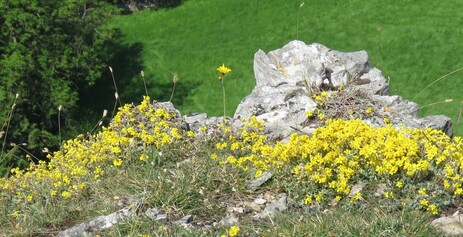 Hoary Rockrose habitat 3 June 2022
Hoary Rockrose habitat 3 June 2022 This week saw bright sun with a strong and blustery wind but a friend saw a male and female adder in a sheltered and sunny spot and he has some impressive photographs. Such a sighting is more likely on still and sultry days when they bask in the sun.
So, to share what I've discovered this Millenium, I'm trawling my photographic archive to highlight Scout Scar and Cunswick specials. Go to The Gallery on my website. Each image is dated so that's a guide to when you may find certain species.
Hoary Rock Rose is rare nationally, so is Blue Moor Grass shown with it above. Both appear on Scout Scar. Hoary Rock Rose is a specialist of the limestone escarpment and grows only on the cliff-face and on the rocky edge. It cannot thrive with competition.
Squinancywort (in the gallery selection) will grow on the rocky track close to the escarpment edge. It's tiny and exquisite, the white petals streaked with pink if you crouch down and look closely. It grows at your feet and is easily confused with white flowers of bedstraw but it's a different species.
Redstart are returned from Africa and are setting up territories. Last week I found a male singing in the territory he claimed last spring. They're beautiful birds. Learn the song and you'll find them if you're patient. Skylark are now in full song. Over some years I've tried for a photograph of the lark ascending. I've included one in The Gallery, a lark poised for flight on a drystone wall on Cunswick Scar, and that first moment as it takes to the air. You have seconds to capture such an image so you have to be very quick.
Redpoll are returned to breed and I think I've heard linnet. The song of linnet is beautiful, so is the bird. If you see a linnet on Scout Scar I'm sure you'll agree they're handsome.
Gallery images are captioned, so click on the image to see them fully. All are copyright as they represent years of study.




 RSS Feed
RSS Feed